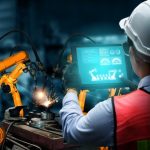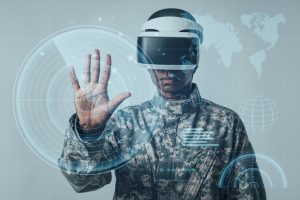VR Technology Use Cases
Industrialisation 5.0 is upon us, and virtual reality (VR) is one of the key technologies shaping the future of the manufacturing industry. VR has truly become a necessary enterprise, with the space expected to grow from £641 million in 2018 to £4.4 billion in 2023. Previously VR was generally associated only with the gaming industry. Now it’s on fire with new opportunities for use. Although this innovative technology has been traditionally associated with the gaming industry, it is amazingly being applied in various fields to manipulate physical surroundings. VR allows its users to experience the real environment in more immersive ways. Here’s a list of industries that are already adopting VR and how this could impact the future of that industry.


Education
VR could revolutionise education by enabling students to learn in an immersive, experiential way. Unimersiv have apps that allow users to take a tour of Ancient Rome, explore the human brain, and board the Titanic. ImmersiveVREducation are building a VR classroom / meeting room space with their ‘Engage’ product, where people can learn from lecturers around the world. Engage application with students learning collaboratively inside a lecture room.
Due to its interactive nature, medical and dental students have begun using VR to practice surgeries and procedures, allowing for a consequence free learning environment; the risk of inflicting harm or making a mistake while practicing on real patients is eliminated. Virtual patients are used to allow students to develop skills which can later be applied in the real world. Using VR technology in the medical industry is an effective way to not only improve the quality of students in training but it also presents a great opportunity to optimise costs, especially since health services are continuously under pressure with tight budgets.
Healthcare
Healthcare in an important application where VR can have a significant impact. Healthcare professionals now use virtual models to prepare themselves for working on real bodies and VR has even been used as pain relief for burn injuries. As mentioned briefly before, VR technology has become a primary method for treating post-traumatic stress. Using VR exposure therapy, a person enters a re-enactment of a traumatic event in an attempt to come to terms with the event and heal. Likewise, it has also been used to treat anxiety, phobias and depression. For example, some patients with anxiety find meditating using VR to be an effective method to manage stress reactivity and boost coping mechanisms. Virtual reality technology can provide a safe environment for patients to come into contact with things they fear, whilst remaining in a controlled and safe environment. This is just one of the ways virtual reality can have a real positive impact on society.
Retail
Tourism and Recreation
Law Enforcement
As with the military, police forces are using AR and VR tools from companies like VirTra to train personnel in simulated scenarios complete with visual, auditory, and physical stimuli (ranging from barking dogs and street noise to the recoil of discharging a weapon). The technologies even enable police forces to escalate or de-escalate trainees’ simulated interactions with individuals inside the virtual training environments, helping learners practice making judgment calls and critical decisions under stress.
The military in the UK and the US have both adopted the use of virtual reality in their training as it allows them to undertake a huge range of simulations. VR is used in all branches of service: the army, navy, air force, marines and coast guard. In a world where technology is adopted from an early age and children are accustomed to video games and computers, VR proves an effect method of training.


VR can transport a trainee into a number of different situations, places and environments for a range of training purposes. The military uses it for flight simulations, battlefield simulations, medic training, vehicle simulation and virtual boot camp, among other things. VR is a completely immersive, visual and sound-based experience, which can safely replicate dangerous training situations to prepare and train soldiers, without putting them at risk until they are ready for combat. Likewise, it can also be used to teach soldiers some softer skills, including communication with local civilians or international counterparts when out in the field. Another of its uses includes treating Post-Traumatic Stress Disorder (PTSD) for soldiers who have returned from combat and need help adjusting to normal life situations; this is known as Virtual Reality Exposure Therapy (VRET). A key benefit for using virtual reality technology in the military is the reduction in costs for training.
Architecture and Real Estate
Learning and Development
Recruitment
Entertainment
Automotive Industry
Sports
The way that we watch sports is already changing, with several VR companies specialising in watching live sports events. For example, you can watch the NBA, NFL, and other events in VR. Companies such as LiveLikeVR enable broadcasters and sports teams to deliver live sports viewing experiences on mobile VR. This is a great way of opening up live sports events to people who can’t travel to the venue or can’t afford tickets to watch the sports in person.
BT Sport broadcasted the UEFA Champions League final in 360 degree VR via YouTube and the BT VR app, all for free. You could watch the game from several locations in the stadium, as if you were actually there. Initiatives like this will help change the way sports are watched.
Art and Design
Events and Conferences
Since VR enables individuals to be places virtually, it provides an avenue for organizers to welcome more individuals into in-person events. For example, Paul McCartney released a 360-degree concert recording through a virtual reality app linked to the inexpensive Google Cardboard headset.
VR can be used in a similar way to enable virtual conference attendance, but event-industry stakeholders are also using it to drive collective experiences among in-person audiences. An example of this was at the Mobile World Congress 2016, when conference attendees wore VR headsets as they attended the launching ceremony of the new Samsung S7 and S7 edge smartphones.
Marketing
Marketing is becoming more and more about how companies make customers feel so using VR is a natural extension. Coca-Cola was one of the first companies to try out virtual experiences in their marketing when they transformed their Christmas advert into VR in Poland.
It’s also becoming popular for universities to create virtual campus tours of universities. Princeton, Yale and Columbia have all tried this out as a way of more students to be able to see their campus.

